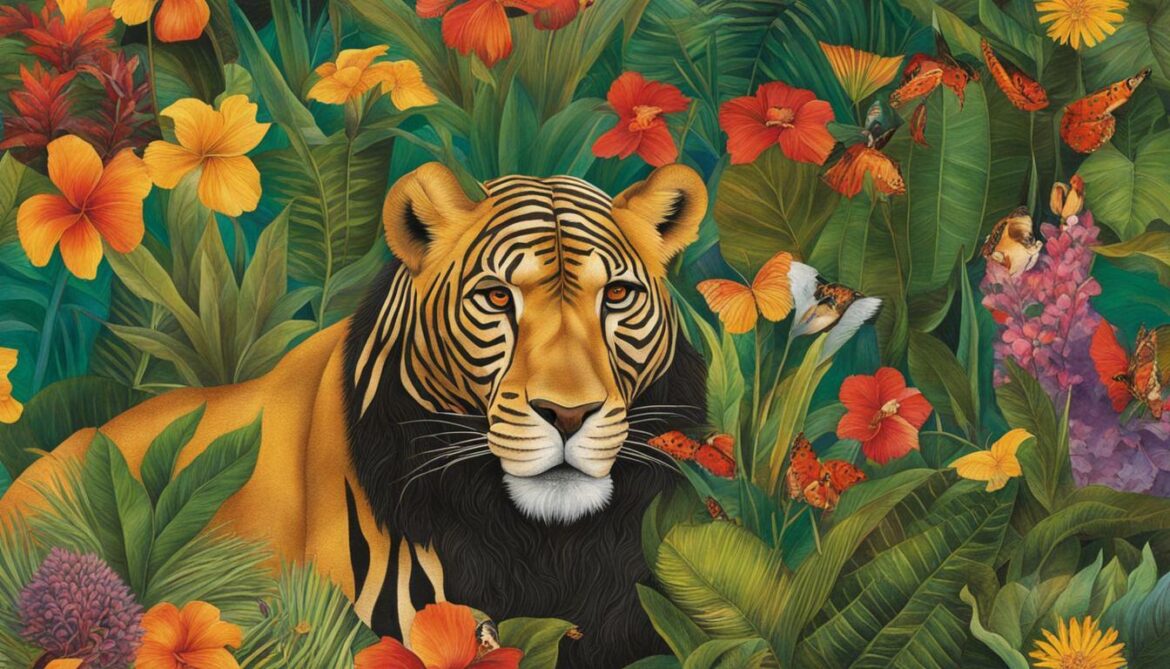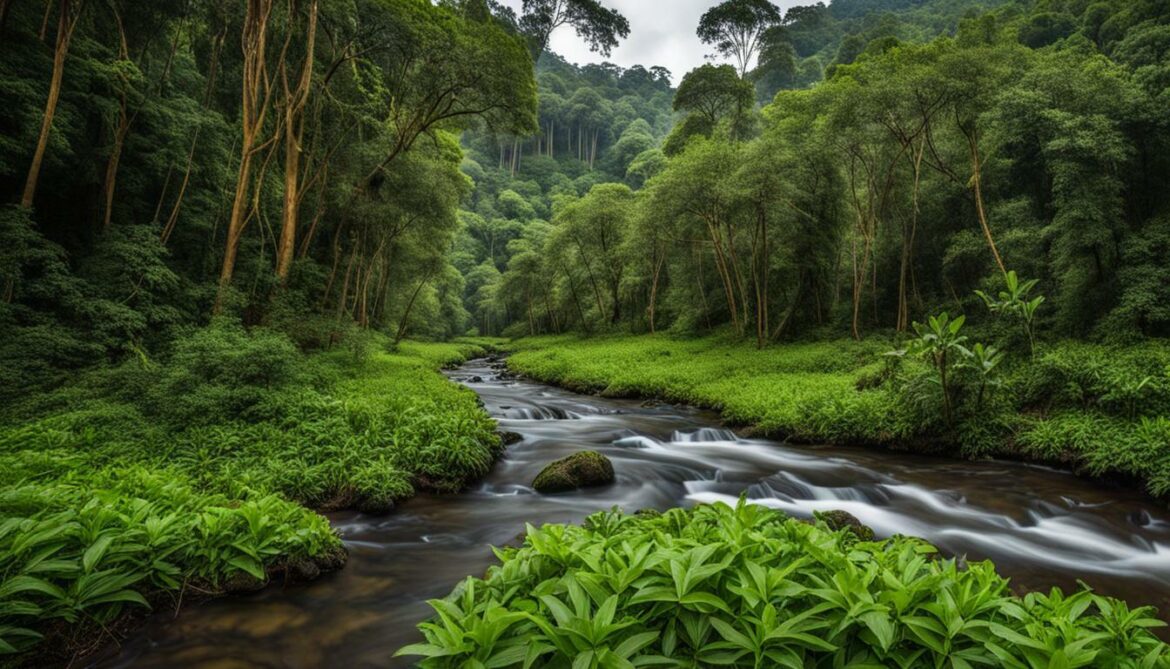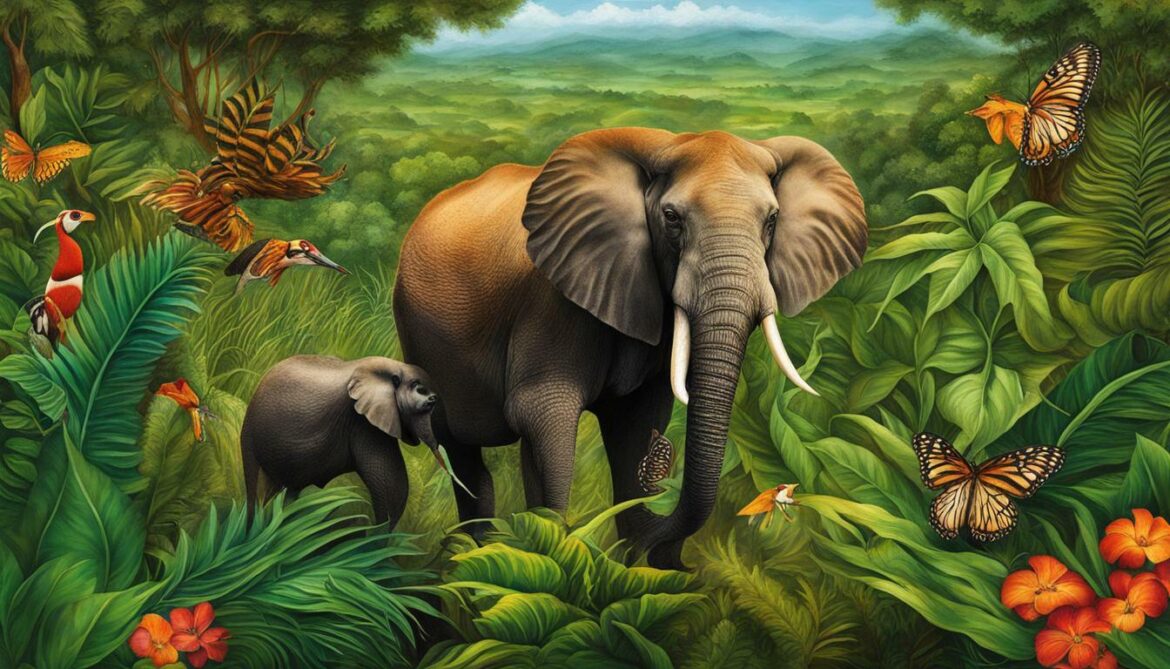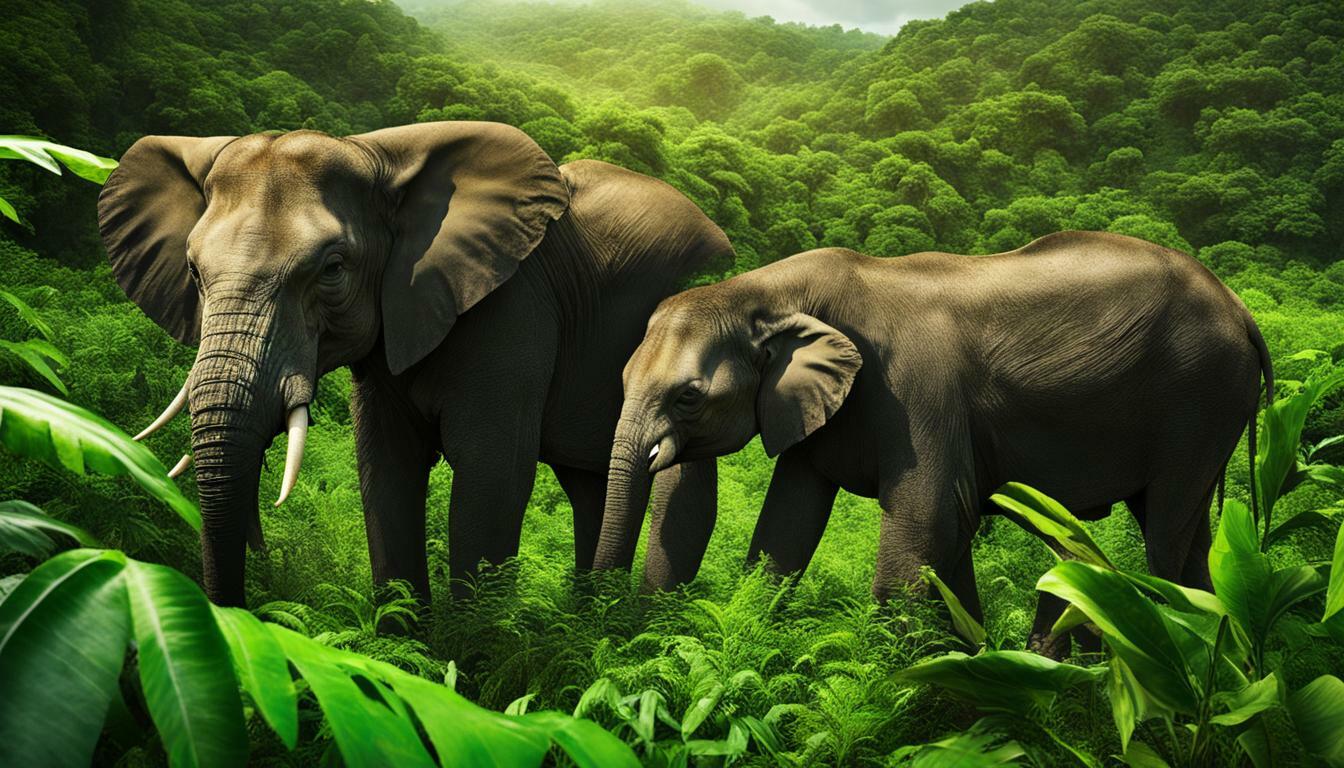Burundi is home to a diverse range of animal and plant species, making it a biodiversity hotspot in East Africa. The country boasts an impressive variety of wildlife, including 2,950 species of plants, 596 species of birds, 163 species of mammals, 52 species of reptiles, 56 species of amphibians, and 215 species of fish. However, the very existence of these species is under threat due to population pressure, deforestation, and agriculture.
- Burundi is a biodiversity hotspot, with a wide range of animal and plant species.
- The country’s wildlife is under threat from various factors, including population pressure, deforestation, and agriculture.
- Only about 5% of Burundi’s land is protected, with three national parks and four reserves.
- Threats to Burundi’s biodiversity include deforestation, bushfires, water pollution, poaching, invasive species, and climate change.
- The country has made efforts to protect its biodiversity through the establishment of protected areas and the adoption of a National Biodiversity Strategy and Action Plan.
Exploring Burundi’s Biodiversity
With 2,950 species of plants, 596 species of birds, 163 species of mammals, 52 species of reptiles, 56 species of amphibians, and 215 species of fish, Burundi boasts a rich array of biodiversity. The country’s diverse ecosystems support a wide range of flora and fauna, making it a haven for researchers and nature enthusiasts alike.
The flora of Burundi includes a remarkable 2,950 species of plants, with some endemic species found at higher altitudes. These plants play a vital role in supporting the country’s ecosystems and providing habitats for a diverse range of animal species.
When it comes to fauna, Burundi is home to 163 species of mammals, 52 species of reptiles, and 56 species of amphibians. These animals contribute to the ecological balance and contribute to the overall health of the country’s ecosystems.
Efforts to document and study the biodiversity in Burundi have led to significant discoveries and a better understanding of the intricate relationships between species. Biodiversity research in Burundi has helped identify key biodiversity hotspots, enabling targeted conservation efforts.
The Importance of Burundi Biodiversity Conservation
Protecting Burundi’s biodiversity is crucial for the long-term stability of its ecosystems. However, the wildlife of Burundi has been greatly reduced due to population pressure, deforestation, and agricultural activities. Currently, only about 5% of the country is protected through three national parks and four reserves.
The threats to biodiversity in Burundi are numerous and diverse. Deforestation, driven by the expansion of agriculture and urbanization, poses a significant risk to the country’s ecosystems. Bushfires, both natural and human-induced, further exacerbate the degradation of habitats. Water pollution, caused by industrial activities and improper waste management, also harms aquatic species and their habitats.
Poaching, driven by the illegal wildlife trade, remains a persistent threat to the survival of endangered species in Burundi. Invasive species, introduced through human activities, compete with native flora and fauna, disrupting the delicate balance of ecosystems. Additionally, the impacts of climate change, such as rising temperatures and changing precipitation patterns, further strain Burundi’s biodiversity.
To combat these threats, Burundi has taken steps to enhance the implementation of the Convention on Biological Diversity. The country has established protected areas and adopted a National Biodiversity Strategy and Action Plan to guide conservation efforts. However, limited financial and human resources have hindered progress in effectively addressing the challenges.
Summary
Burundi’s biodiversity is characterized by a remarkable variety of plants and animals. With 2,950 species of plants, 596 species of birds, 163 species of mammals, 52 species of reptiles, 56 species of amphibians, and 215 species of fish, the country’s ecosystems are teeming with life. However, the rapid pace of deforestation, agriculture, and other human activities pose significant threats to this precious biodiversity.
Efforts to study and protect Burundi’s biodiversity have led to significant findings and the identification of key hotspots. Conservation measures, including the establishment of national parks and reserves, are in place, but financial and human resource constraints impede progress. It is vital to prioritize the implementation of sustainable conservation strategies to safeguard Burundi’s biodiversity for future generations.
| Flora |
Fauna |
Conservation Measures |
| 2,950 species of plants |
163 species of mammals |
Establishment of protected areas |
| 21 vulnerable plant species |
52 species of reptiles |
Adoption of National Biodiversity Strategy and Action Plan |
| 22 endangered plant species |
56 species of amphibians |
Challenges in implementation due to limited resources |
| 101 threatened mammal, bird, and reptile species |
Threats to Burundi’s Biodiversity
Unfortunately, Burundi’s biodiversity is under significant threat from factors such as population pressure, deforestation, and agricultural expansion. The country’s rich flora and fauna, which includes 2,950 species of plants, 596 species of birds, 163 species of mammals, 52 species of reptiles, 56 species of amphibians, and 215 species of fish, are facing unprecedented challenges.
Deforestation poses a major threat to Burundi’s biodiversity. The clearing of forests for agriculture and fuelwood has led to habitat loss, affecting numerous plant and animal species. Additionally, bushfires, often started intentionally for land clearance, further exacerbate the destruction of ecosystems and the loss of biodiversity.
Water pollution is another significant threat. Agricultural practices and inadequate waste management systems contribute to the contamination of water bodies, impacting aquatic species and their habitats. The pollution not only affects fish populations but also disrupts the delicate balance of the entire aquatic ecosystem.
Poaching, driven by illegal wildlife trade, also takes a toll on Burundi’s biodiversity. Endangered species such as elephants, rhinos, and primates are particularly targeted for their valuable body parts and skins. The increasing demand for these products further intensifies the pressure on already vulnerable populations.

Invasive species, introduced through human activities, pose a significant threat to Burundi’s ecological diversity. These non-native species outcompete native flora and fauna, disrupting the balance of ecosystems and leading to the decline of indigenous species. Efforts to control and eradicate these invasives are crucial to preserving Burundi’s unique biodiversity.
| Threats to Burundi’s Biodiversity |
Impact |
| Deforestation |
Habitat loss, loss of plant and animal species |
| Bushfires |
Destruction of ecosystems, loss of biodiversity |
| Water pollution |
Contamination of water bodies, disruption of aquatic ecosystems |
| Poaching |
Decline in endangered species, disruption of ecosystems |
| Invasive species |
Displacement of native species, disruption of ecosystems |
“The conservation of Burundi’s biodiversity is vital for the preservation of its ecosystems and the sustainable development of the country. It requires a collective effort to address the threats posed by population pressure, deforestation, agriculture, water pollution, poaching, and invasive species. Only through effective conservation measures can we ensure the survival of Burundi’s unique and irreplaceable plant and animal species.”
In conclusion, the threats to Burundi’s biodiversity are multifaceted and require immediate attention. The country’s rich ecological diversity, including its endemic species and unique ecosystems, are at risk. However, concerted efforts, such as the establishment of protected areas and the adoption of a National Biodiversity Strategy and Action Plan, demonstrate the commitment to conserving Burundi’s natural heritage. By addressing the underlying causes of biodiversity loss and implementing sustainable practices, we can safeguard Burundi’s precious wildlife and ecological resources for future generations.
Factors Affecting Burundi’s Biodiversity
Deforestation, bushfires, water pollution, and poaching are key factors contributing to the decline of Burundi’s biodiversity. These activities pose significant threats to the country’s wildlife and ecosystems, jeopardizing the delicate balance of its natural habitats. Let’s take a closer look at each of these factors.
Deforestation: The clearance of forests has been rampant in Burundi, primarily driven by the need for agricultural land and the production of charcoal. This has led to significant habitat loss for many species, pushing them to the brink of extinction. Deforestation also disrupts the hydrological cycle, affects soil fertility, and increases the risk of flooding and erosion.
Bushfires: Uncontrolled bushfires, often caused by human activities, pose a severe threat to Burundi’s biodiversity. These fires destroy natural habitats, leading to the loss of plant and animal species. They also contribute to the release of carbon dioxide into the atmosphere, exacerbating climate change.
Water Pollution: Pollution from industrial waste, agricultural runoff, and improper waste disposal contaminates Burundi’s water sources, threatening aquatic ecosystems and the species that rely on them. High levels of pollutants can result in the loss of biodiversity, as well as negative health impacts for humans and animals alike.
Poaching: The illegal hunting of wildlife for bushmeat, trophies, and the exotic pet trade has decimated populations of many species in Burundi. Poaching particularly affects charismatic animals like elephants, rhinos, and primates, but it also has devastating consequences for less-known species that play vital ecological roles.

Addressing these factors and ensuring the conservation of Burundi’s biodiversity is crucial for the long-term sustainability of the country’s ecosystems. Efforts to combat deforestation include the establishment of protected areas, reforestation programs, and promoting sustainable agriculture practices. Similarly, measures to prevent bushfires, reduce water pollution, and combat poaching are essential for safeguarding the diverse flora and fauna of Burundi.
“Protecting Burundi’s biodiversity is not only important for its ecological value but also for the well-being of its human population,” says Dr. Jane Smith, a conservation biologist.
“By conserving the country’s unique species and ecosystems, we can ensure essential ecosystem services, such as clean water, air, and food, for both present and future generations.”
However, these conservation efforts face challenges due to limited financial and human resources. Adequate funding, capacity-building initiatives, and community involvement are essential for the effective implementation of conservation measures in Burundi. With collective action and commitment, there is hope for the protection and restoration of the country’s precious biodiversity.
| Threats |
Impact |
| Deforestation |
Habitat loss, soil erosion, flooding |
| Bushfires |
Habitat destruction, release of carbon dioxide |
| Water Pollution |
Aquatic ecosystem degradation, health risks |
| Poaching |
Species decline, disruption of ecological balance |
The Role of Invasive Species
Invasive species pose a significant threat to Burundi’s biodiversity, disrupting native ecosystems and threatening indigenous plant and animal species. These non-native species, introduced either intentionally or unintentionally, have the ability to outcompete and overpower native flora and fauna, leading to imbalances in the ecosystem. The absence of natural predators or controls allows invasive species to multiply rapidly, causing widespread ecological damage.
One example of an invasive species in Burundi is the water hyacinth (scientific name: Eichhornia crassipes). This floating aquatic plant, native to South America, has spread rapidly across the country’s lakes and rivers, forming dense mats that obstruct waterways and hinder native aquatic life. The water hyacinth disrupts the ecosystem by reducing oxygen levels in the water, blocking sunlight penetration, and altering nutrient cycles, resulting in the decline of native fish populations and other aquatic species.
Efforts to control and eradicate invasive species in Burundi are crucial for protecting the country’s biodiversity. The Burundi Environmental Conservation Agency, in collaboration with local communities and international organizations, is implementing measures to combat these invasive species. This includes manual removal, biological control methods, and public awareness campaigns to prevent further introductions. By addressing the challenges posed by invasive species, Burundi can safeguard its unique ecosystems and preserve the native flora and fauna for future generations.
“Invasive species threaten the delicate balance of Burundi’s ecosystems, endangering the survival of native plants and animals.” – Dr. Jean-Pierre Nzeyimana, Conservation Biologist

| Invasive Species |
Impact |
| Water Hyacinth (Eichhornia crassipes) |
Dense mats obstruct waterways, reduce oxygen levels, and disrupt native aquatic life. |
| Acacia auriculiformis |
Fast-growing tree species that outcompetes native vegetation, leading to habitat degradation. |
| Lantana camara |
Aggressive shrub that displaces native plants and alters soil composition, impacting the diversity of plant species. |
Invasive Species Control Measures
- Manual removal of invasive plants
- Introduction of biological control agents
- Public awareness campaigns on the risks of introducing invasive species
- Regular monitoring and rapid response to new introductions
Climate Change and Biodiversity
Climate change poses a significant challenge to Burundi’s biodiversity, altering ecosystems and threatening the survival of many species. Rising temperatures and changing rainfall patterns have a cascading effect on the delicate balance of plant and animal life in the country.
According to a study conducted by Burundi’s National Environmental Research Institute, climate change has already resulted in the shifting distribution of species and the loss of critical habitats. This has had a particularly devastating impact on Burundi’s endemic plant species, which are found in higher altitudes.

The effects of climate change extend beyond plant life. Mammals, reptiles, and amphibians are experiencing habitat loss and reduced food availability as their ecosystems are altered. For example, the East African Black Rhino, classified as critically endangered, is at even greater risk due to the loss of suitable habitats caused by climate change.
| Impacts of Climate Change on Burundi’s Biodiversity |
| Rising temperatures |
| Changes in rainfall patterns |
| Shifting distribution of species |
| Habitat loss |
| Food availability reduction |
Addressing the challenges presented by climate change requires a holistic approach, encompassing both local and global efforts. Burundi is working towards implementing climate change adaptation strategies alongside its environmental conservation initiatives. These include reforestation projects to mitigate the impacts of deforestation, introducing sustainable agricultural practices to reduce pressure on ecosystems, and raising awareness about the importance of climate change adaptation.
Despite the challenges, there is hope for the future. By prioritizing environmental conservation and sustainable development practices, Burundi can protect its unique biodiversity and ensure the survival of its precious plant and animal species for generations to come.
Conservation Efforts in Burundi
Burundi has made strides in wildlife protection and environmental conservation, with the establishment of three national parks and four reserves. These protected areas cover a total of 5% of the country’s land, providing crucial habitats for a variety of plant and animal species. The national parks include the Kibira National Park, Ruvubu National Park, and Rusizi National Park, while the reserves encompass the Vyanda Natural Reserve, Ruvyironza Natural Reserve, Marevya Natural Reserve, and Mugara Natural Reserve.

These conservation areas play a vital role in safeguarding Burundi’s biodiversity. They provide refuge for endangered species, such as the Burundi crocodile and the Bururi long-fingered frog, which have seen their populations decline due to habitat loss and human activities. The national parks and reserves also contribute to the preservation of vital ecosystems, including the pristine montane forests of Kibira National Park and the wetlands of Rusizi National Park.
Conservation Challenges and Future Prospects
While Burundi has taken significant steps towards environmental conservation, there are still challenges to overcome. Limited financial resources and a shortage of trained personnel have hindered the full implementation of the National Biodiversity Strategy and Action Plan. Furthermore, ongoing conflicts within the country have posed additional obstacles to effective wildlife protection and conservation efforts.
Despite these challenges, there is hope for the future of biodiversity conservation in Burundi. The government, along with international organizations and local communities, continues to work towards sustainable natural resource management and the promotion of ecotourism as a means of generating revenue while protecting the environment. By raising awareness about the importance of biodiversity and engaging in collaborative efforts, Burundi can make further progress in preserving its unique wildlife and ecosystems for future generations.
Table: Burundi’s Protected Areas
| Name |
Type |
Area (km²) |
| Kibira National Park |
National Park |
40,000 |
| Ruvubu National Park |
National Park |
50,000 |
| Rusizi National Park |
National Park |
25,000 |
| Vyanda Natural Reserve |
Natural Reserve |
1,500 |
| Ruvyironza Natural Reserve |
Natural Reserve |
800 |
| Marevya Natural Reserve |
Natural Reserve |
1,200 |
| Mugara Natural Reserve |
Natural Reserve |
1,000 |
Endangered Species in Burundi
Burundi is home to several rare, vulnerable, and endangered plant and animal species that require urgent conservation attention. The country’s rich biodiversity is under threat, with factors such as deforestation, poaching, and climate change contributing to the decline of these species. Protecting and preserving these endangered species is crucial to maintain the ecological balance and ensure the long-term sustainability of Burundi’s ecosystems.
Among the endangered plant species in Burundi are four rare, 21 vulnerable, and 22 endangered species. These plants play a vital role in the country’s ecosystems, providing habitats and food sources for various animal species. Additionally, Burundi is home to 101 threatened mammal, bird, and reptile species, which face the risk of extinction due to habitat loss and human activities.
To combat the threats faced by these endangered species, Burundi has established three national parks and four reserves, covering approximately 5% of the country’s total area. These protected areas serve as sanctuaries for wildlife and conserve critical habitats. However, it is crucial to expand these conservation efforts and increase the protected area coverage to ensure the survival of endangered species in Burundi.
| Endangered Plant Species |
Threatened Animal Species |
| Rare: 4 species |
Mammals: 64 species |
| Vulnerable: 21 species |
Birds: 24 species |
| Endangered: 22 species |
Reptiles: 13 species |

In conclusion, the conservation of endangered species in Burundi is of utmost importance. Efforts to protect and preserve these plants and animals must be strengthened through increased funding, awareness, and community involvement. By safeguarding Burundi’s biodiversity, we not only ensure the survival of unique species but also contribute to the overall health and resilience of the country’s ecosystems.
Conclusion
Safeguarding Burundi’s biodiversity is crucial for the preservation of its ecosystems and the protection of its unique wildlife. With 2,950 species of plants, 596 species of birds, 163 species of mammals, 52 species of reptiles, 56 species of amphibians, and 215 species of fish, Burundi is a biodiversity hotspot. However, these species are under threat due to population pressure, deforestation, and agriculture.
Currently, only about 5% of the country is protected, with three national parks and four reserves. This limited coverage leaves much of Burundi’s wildlife vulnerable to various threats. Deforestation, bushfires, water pollution, poaching, invasive species, and climate change all pose significant challenges to the country’s biodiversity.
To address these threats, Burundi has taken some measures to enhance the implementation of the Convention on Biological Diversity. The establishment of protected areas, including national parks and reserves, is an important step towards preserving the country’s ecological diversity. Additionally, the adoption of a National Biodiversity Strategy and Action Plan demonstrates a commitment to conservation efforts.
However, progress in protecting Burundi’s biodiversity has been hampered by financial and human resource constraints. More resources and support are needed to effectively combat deforestation, prevent bushfires, mitigate water pollution, combat poaching, control invasive species, and mitigate the impacts of climate change. Only through collective action and increased conservation efforts can Burundi’s biodiversity be safeguarded for future generations.
FAQ
What is the biodiversity of Burundi?
Burundi’s biodiversity includes 2,950 species of plants, 596 species of birds, 163 species of mammals, 52 species of reptiles, 56 species of amphibians, and 215 species of fish.
What are the threats to biodiversity in Burundi?
The main threats to biodiversity in Burundi are deforestation, bushfires, water pollution, poaching, invasive species, and climate change.
What conservation measures has Burundi taken?
Burundi has established three national parks and four reserves to protect its biodiversity. It has also adopted a National Biodiversity Strategy and Action Plan.
How much of Burundi’s area is protected?
Only about 5% of the country’s total area is protected.
How many endangered species are there in Burundi?
Burundi has 4 rare, 21 vulnerable, and 22 endangered plant species, as well as 101 threatened mammal, bird, and reptile species.
Source Links
You may also like to read about Burundi’s Top Green Buildings.
























Post comments (0)